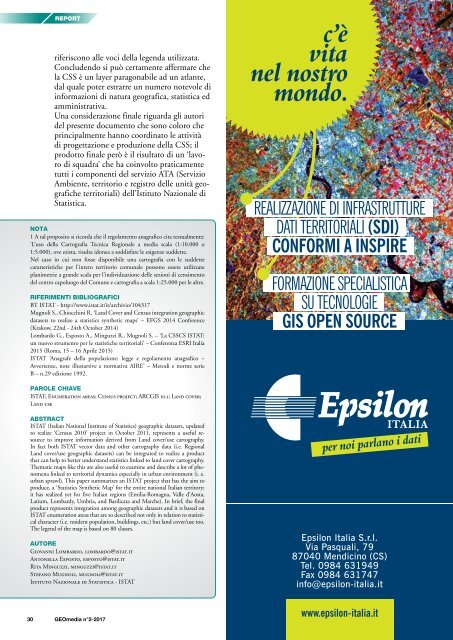GEOmedia_2 2017
Create successful ePaper yourself
Turn your PDF publications into a flip-book with our unique Google optimized e-Paper software.
REPORT<br />
riferiscono alle voci della legenda utilizzata.<br />
Concludendo si può certamente affermare che<br />
la CSS è un layer paragonabile ad un atlante,<br />
dal quale poter estrarre un numero notevole di<br />
informazioni di natura geografica, statistica ed<br />
amministrativa.<br />
Una considerazione finale riguarda gli autori<br />
del presente documento che sono coloro che<br />
principalmente hanno coordinato le attività<br />
di progettazione e produzione della CSS; il<br />
prodotto finale però è il risultato di un ‘lavoro<br />
di squadra’ che ha coinvolto praticamente<br />
tutti i componenti del servizio ATA (Servizio<br />
Ambiente, territorio e registro delle unità geografiche<br />
territoriali) dell’Istituto Nazionale di<br />
Statistica.<br />
NOTA<br />
1 A tal proposito si ricorda che il regolamento anagrafico cita testualmente:<br />
‘L’uso della Cartografia Tecnica Regionale a media scala (1:10.000 o<br />
1:5.000), ove esista, risulta idonea a soddisfare le esigenze suddette.<br />
Nel caso in cui non fosse disponibile una cartografia con le suddette<br />
caratteristiche per l’intero territorio comunale possono essere utilizzate<br />
planimetrie a grande scala per l’individuazione delle sezioni di censimento<br />
del centro capoluogo del Comune e cartografia a scala 1:25.000 per le altre.<br />
RIFERIMENTI BIBLIOGRAFICI<br />
BT ISTAT - http://www.istat.it/it/archivio/104317<br />
Mugnoli S., Chiocchini R. ‘Land Cover and Census integration geographic<br />
datasets to realize a statistics synthetic maps’ – EFGS 2014 Conference<br />
(Krakow, 22nd - 24th October 2014)<br />
Lombardo G., Esposto A., Minguzzi R., Mugnoli S. – ‘La CSSCS ISTAT:<br />
un nuovo strumento per le statistiche territoriali’ – Conferenza ESRI Italia<br />
2015 (Roma, 15 – 16 Aprile 2015)<br />
ISTAT ‘Anagrafe della popolazione: legge e regolamento anagrafico –<br />
Avvertenze, note illustartive e normativa AIRE’ – Metodi e norme serie<br />
B – n.29 edizione 1992.<br />
PAROLE CHIAVE<br />
ISTAT; Enumeration areas; Census project; ARCGIS 10.1; Land cover;<br />
Land use<br />
ABSTRACT<br />
ISTAT (Italian National Institute of Statistics) geographic datasets, updated<br />
to realize ‘Census 2010’ project in October 2011, represents a useful resource<br />
to improve information derived from Land cover/use cartography.<br />
In fact both ISTAT vector data and other cartography data (i.e. Regional<br />
Land cover/use geographic datasets) can be integrated to realize a product<br />
that can help to better understand statistics linked to land cover cartography.<br />
Thematic maps like this are also useful to examine and describe a lot of phenomena<br />
linked to territorial dynamics especially in urban environment (i. e.<br />
urban sprawl). This paper summarizes an ISTAT project that has the aim to<br />
produce, a ‘Statistics Synthetic Map’ for the entire national Italian territory;<br />
it has realized yet for five Italian regions (Emilia-Romagna, Valle d’Aosta,<br />
Latium, Lombardy, Umbria, and Basilicata and Marche). In brief, the final<br />
product represents integration among geographic datasets and it is based on<br />
ISTAT enumeration areas that are so described not only in relation to statistical<br />
character (i.e. resident population, buildings, etc.) but land cover/use too.<br />
The legend of the map is based on 80 classes.<br />
AUTORE<br />
Giovanni Lombardo, lombardo@istat.it<br />
Antonella Esposto, esposto@istat.it<br />
Rita Minguzzi, minguzzi@istat.it<br />
Stefano Mugnoli, mugnoli@istat.it<br />
Istituto Nazionale di Statistica - ISTAT<br />
30 <strong>GEOmedia</strong> n°2-<strong>2017</strong>


















